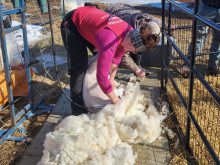MOOSE JAW, Sask. – Canadian demand for lamb is increasing at the same rate that domestic production is declining, leaving the industry in a quandary.
Jennifer Fleming-MacTavish, executive director of the Canadian Sheep Federation, told a producer workshop in Moose Jaw that the ewe inventory has shrunk by more than 100,000 head in the last five years.
However, consumption has increased 10 percent and imports increased by 70 percent between 2004 and 2006 to fill demand.
New Zealand lamb usually fills the import need, but Fleming-MacTavish said that country’s flock is also decreasing as producers switch to dairy production. In Australia, which had been increasing exports to Canada, drought is limiting production.
Read Also

Charges laid after cattle theft
Saskatchewan RCMP lay two charges against a man after six cattle went missing.
A changing Canadian demographic and an industry marketing strategy are pushing demand.
By 2017, about 25 percent of the Canadian population will be a visible minority, Fleming-MacTavish said. She noted that people of Saudi Arabian background eat 17 kilograms of lamb per capita, while Canadians eat 1.26 kg per capita.
The federation’s 2006 marketing strategy included among its goals a consumption increase of .25 kg per person within five years.
“We’re bang on,” she said.
“We are in an enviable position. We have to figure out how to maximize this without negatively influencing any other sector.”
Surveys show 57 percent of meat consumers have eaten lamb in the past year, compared to 99 percent for chicken, 97 percent for pork and 52 percent for veal.
Seventy-three percent eat lamb less than six times per year. Eighty percent buy it at a large grocery store and 20 percent eat it in restaurants.
Consumption is highest in British Columbia.
Respondents said they view Canadian lamb as fresher and tastier than New Zealand lamb, but the latter has a better reputation for availability and consistency.
Fleming-MacTavish said producers should think about how to make their ewes more efficient and how to increase the number of lambs per ewe they are marketing.
In New Zealand, productivity is measured in kilograms of meat per hectare of grass, she said. Canadians must do the same, she added.
The industry also needs to recruit new people, which includes producers who already raise livestock but are willing to take on another species.
Fleming-MacTavish said the industry must support producers. For example, it could organize lender seminars to educate bankers on sheep production and profitability models.
Producers should also have better access to industry experts and advice, she added.

















